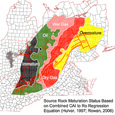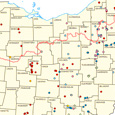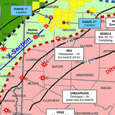Chevron well fire: Pa. DEP issues air monitoring report
Wednesday, April 23, 2014

PITTSBURGH — The Department of Environmental Protection (DEP) issued a report April 23 concluding that no pollutants that would indicate a potential health concern for local residents or emergency responders were found as a result of the Greene County Chevron well fire incident.
“In order to ensure public health and safety, DEP immediately went to work on an aggressive sample regimen,” DEP Secretary E. Christopher Abruzzo said. “It was a top priority of the department to be certain that emergency response workers and nearby residents were not harmed by any emissions caused by this incident.”
Samples
DEP took samples from several locations, both upwind and downwind of the well pad. Sampling was conducted from Feb. 12, the day after the fire began, to Feb. 20, when the well was capped. Those samples were analyzed for 57 toxic air pollutants.
While none of the pollutant levels were found to be a threat to health, there were higher concentrations of propane, heptane and 1,2,4-trimethylbenzene than are typically found in other rural areas across the state. However, DEP cannot verify that these concentrations occurred because of the fire and uncontrolled gas leak.
Heptane often comes from crude oil and is used in paints and solvents; 1,2,4-trimethylbenzene is usually found in coal tar or oil; and the higher concentrations of propane are believed to have come from nearby storage tanks.
Public exposure
DEP used air sampling canisters to collect both instantaneous samples (“grab” samples) and 24-hour samples in its efforts to determine potential public exposure to air pollution from the incident.
Each day of the sampling period, two grab samples were collected near residences located downwind of the fire. To serve as an air quality benchmark, a single daily upwind grab sample was also obtained. In addition, one 24-hour continuous sample was taken at one of the two downwind sample sites.
Department analysts compared the upwind and downwind samples in order to estimate the air toxics concentration during the nine days of the event. The samples were also compared to data gathered by the 24-hour method.
Pollution extent
By comparing the sample readings with historic toxic air concentrations at three other air monitoring sites in the state, analysts were able to determine the extent of any toxic pollution during the incident. In this case, the samples gathered at the Greene County site were compared to a rural location that is generally not impacted by air pollution and two urban sites with differing toxic pollution sources.
The control sites served as a benchmark to show typical air quality for this region of the state, providing the department with a better understanding of any impact that may have been a result of the incident.
To view the air monitoring report, go to: http://www.portal.state.pa.us/portal/server.pt/community/oil—and—gas/6003




